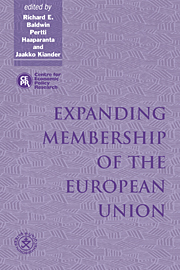Book contents
- Frontmatter
- Contents
- List of figures
- List of tables
- Preface
- Acknowledgements
- List of conference participants
- 1 Introduction
- PART ONE THEORETICAL ISSUES
- PART TWO POLICY ISSUES
- PART THREE EMPIRICAL ISSUES
- 8 Regional effects of European integration
- 9 Implications of EU expansion for European agricultural policies, trade and welfare
- 10 The economic consequences of EU enlargement for the entrants: the case of Finland
- Index
10 - The economic consequences of EU enlargement for the entrants: the case of Finland
Published online by Cambridge University Press: 05 November 2011
- Frontmatter
- Contents
- List of figures
- List of tables
- Preface
- Acknowledgements
- List of conference participants
- 1 Introduction
- PART ONE THEORETICAL ISSUES
- PART TWO POLICY ISSUES
- PART THREE EMPIRICAL ISSUES
- 8 Regional effects of European integration
- 9 Implications of EU expansion for European agricultural policies, trade and welfare
- 10 The economic consequences of EU enlargement for the entrants: the case of Finland
- Index
Summary
Introduction
The accession of Austria, Finland and Sweden into the EU was prompted by a series of changes that took place in Europe in the 1980s and early 1990s. This process started in 1985, when the then EC launched its internal market programme. As exports to the EC made up 60 per cent of their total exports, the EFTA countries felt that the internal market programme could pose a severe threat to them in the form of trade diversion. This prompted the EFTA countries to reach an agreement on the formation of the European Economic Area (EEA), which after many ups and downs came into being at the beginning of 1994. In effect, the EU internal market was enlarged to encompass the EFTA countries as well, but with the exclusion of Switzerland.
Initially, the EFTA governments sought to ensure access to the Single Market for their firms without having to join the EU. During the EEA process, the end of the East–West confrontation in Europe sparked off a new political orientation in the EFTA countries, most of which have traditionally pursued neutrality in their foreign policies. Simultaneously, Finland and the other EFTA countries started to feel that under the EEA they would only have rather limited power to influence European cooperation and EU decision making with respect to the enforcement of the Single Market measures and their future development, which is particularly vital to them.
- Type
- Chapter
- Information
- Expanding Membership of the European Union , pp. 240 - 263Publisher: Cambridge University PressPrint publication year: 1995
- 1
- Cited by



